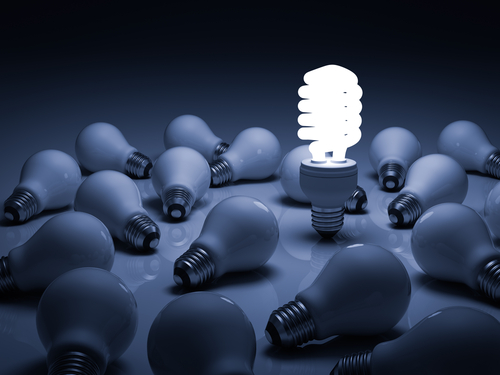Did you know: you can save more on electricity bills than you’ve probably estimated by switching over to energy saving light bulbs. And the best news: switching is easier and less expensive than you think.
In most American homes, lighting accounts for up to 18% of energy usage. To paint an even grimmer picture of this, 90% of the energy usage from a traditional incandescent light bulb (which is also known as a Tungsten Filament or General Lighting Service) is converted to heat and wasted away. This essentially means that a whole lot of money is allocated to ineffective energy use.
With the right bulb, though, you’re guaranteed to spend less on your next bill.
Energy Efficient Lighting
Halogen Incandescent, Compact Florescent Lamps (CFL), and Light Emitting Diodes (LEDs) are three notable energy-saving light bulbs, and each type is able to last 3-25 times longer than traditional light bulbs. Switching all light fixtures in your home to top-ranking energy-efficient bulbs can save you up to $75 annually.
Halogen Incandescent – Inside a Halogen Incandescent light fixture is a filament that holds gas and increases bulb efficiency. They provide brighter and longer lasting light than traditional incandescent light bulbs. While the Halogen Incandescent light bulb significantly supersedes its predecessor, it’s outdated in comparison to the newer and better configured light bulbs—CFLs and LEDs.
Compact Florescent Light Bulbs (CFLs) – These light bulbs are the miniature spiral versions of the florescent tubes you see often in schools and doctors’ offices. They screw in to bulb fixtures, emitting light similar — though significantly more powerful and efficient — than an incandescent bulb. CFLs are far more efficient than halogen incandescent light bulbs, using approximately one-third of the energy. They use one-fourth the energy used by their incandescent counterparts and last ten times longer. Switching to an 18 Watt CFL in place of a 75 Watt incandescent can translate to savings of up to $45.
Unfortunately, CFLs contain small traces of mercury which could be released when or if bulb breaks, or during disposal. Proper care and disposal is mandatory.
Light Emitting Diodes or LEDs – LEDs are highly efficient, solid state lighting that operate by conducting energy to light. They can last up to ten times as long as CFLs, without the added negativity of containing any harmful chemical substance. Additionally, LEDs use 25%-30% of the energy required to operate other bulbs and last 8 to 25 times as long as halogen incandescent light bulbs. An equally great feature accompanying LEDs are their ability to retain coolness, preventing heat buildup thereby reducing air conditioning usage. Though initially more expensive than all other light bulbs, their benefits far outweigh the costs and they pay off in the long run.
Shopping for Energy-Efficient Light Bulbs
Picking out a great, long-lasting energy-saving light bulb can get a little complex, especially if you’re not familiar with what to look for. A common mistake is to base watts as the tool of light bulb measurement, thereby equating higher value to light bulbs with higher watts. This is wrong. The wattage is only indicative of the amount of energy the bulb consumes. You should really be looking for bulbs with less watts and higher lumens.
Lumen – Lumens indicate the brightness of the bulb in question: the higher the lumen, the brighter the bulb. For example, a 40 Watt incandescent light is the counterpart of an 8-12 Watt CFL and a 6-9 Watt LED—the brightness to which is 400-500 lumens.
Once you know your desired brightness, you’re good to go. What’s left is to choose your desired bulb aesthetics.
Just remember that though initially costly, energy-efficient light bulbs will eventually pay off and save you more money in the long run. Also take note—saving money requires your conscientious effort: turn off all lights when they’re not in use, and don’t use more than what you truly need.


 FREE Live Music and Family Fun at Allied Gardens First Fridays The next Allied Gardens First Fridays Summer Concert in the Park is just around the corner. Grab your lawn chairs, bring a picnic, and get ready to meet your
FREE Live Music and Family Fun at Allied Gardens First Fridays The next Allied Gardens First Fridays Summer Concert in the Park is just around the corner. Grab your lawn chairs, bring a picnic, and get ready to meet your  Ideal Plumbing Heating Air Electrical Named Winner of 2023 Better Business Bureau Torch Awards for Ethics in San Diego (San Diego, CA – September 15, 2023) Better Business Bureau Serving the Pacific Southwest (BBB) has named Ideal Plumbing Heating
Ideal Plumbing Heating Air Electrical Named Winner of 2023 Better Business Bureau Torch Awards for Ethics in San Diego (San Diego, CA – September 15, 2023) Better Business Bureau Serving the Pacific Southwest (BBB) has named Ideal Plumbing Heating